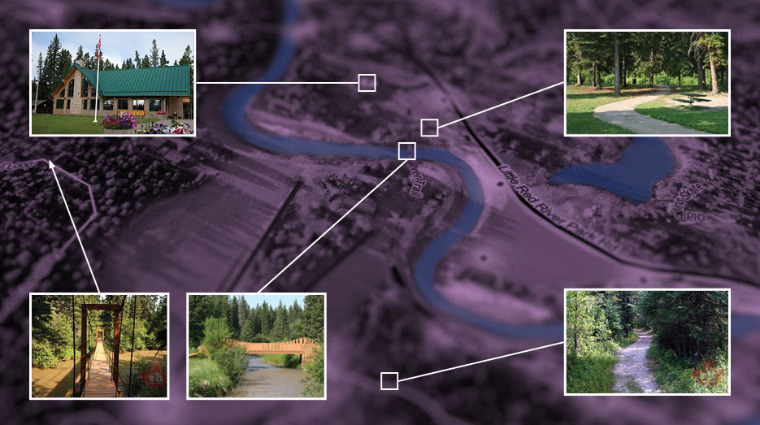
Sask Polytech students, instructors collaborate with City of Prince Albert on interactive map of Little Red River Park.
Little Red River Park is a 1,200-acre natural oasis on the north side of the North Saskatchewan River in Prince Albert. It is the crown jewel in the city’s park system and a much-loved four-season destination for residents and outdoor enthusiasts. One regular park user is Joanne Marchand, an instructor in the School of Natural Resources and Built Environment.
“Every fall, I take my Plant Taxonomy class out to ‘Little Red’ on field trips to reinforce plant identification, and every winter, I take my Parks 400 class out to learn about trail usage, trail development and interpretation,” Joanne says. “There are established trails and lots of little connecting trails, but no easy way to see where they all lead. I thought how much easier it would be if there was an app that could show your immediate location, the trails, buildings and landmarks.”
In the spring of 2019, Joanne approached Tim Yeaman, parks manager at the City of Prince Albert, about partnering to develop an interactive map of the park. “Tim had worked with us on an invasive species project in 2017,” Joanne says, “and he was open and supportive of this project.”
“The City enthusiastically and strongly supports the partnership we have built with Sask Polytech students and instructors on numerous projects completed over the last several years,” Yeaman says, “This partnership allows us to take a collaborative approach to encouraging students to use their skills in an environment that helps to support that.”
A seed grant from Sask Polytech’s Office of Applied Research and Innovation and additional funding from the Saskatchewan Lotteries Community Grant Program enabled Joanne to recruit two of her students to the project.
“As part of the Integrated Resource Management (IRM) program, students are required to complete a research project. Applied research projects boost student confidence by giving them a chance to tackle bigger assignments with real world consequences,” Joanne says. “I had two students who were interested in the park and had considerable skills with Geographic Information Sciences, Kevin Benmerrouche and Camille Crosland.”
Kevin and Camille worked through the summer and fall developing a mapping system application, or app, using the combined technologies of Global Positioning Systems (GPS)), Geographic Information Sciences (GIS) and computer programming. Kevin led the digital mapping component, while Camille organized stakeholder meetings and did more of the “boots-on-the-ground” work.
“I went out with a GPS to physically map out each trail and take notes about usage, amenities, conditions and so on,” Camille says. “I also organized meetings with the City and stakeholder groups, so we could get everyone’s input. The Prince Albert Nordic Ski Club and Rock ‘n’ Road Cycling Club had both done a lot of previous work creating trail maps, and they were really good about sharing that information.”
Kevin also did some GPS mapping, but focused more on the digital component. “I’d show Camille what we needed, then she’d go out and get it. I’d upload the information, digitize it and clean it up. We also worked with a team from the Computer Systems Technology program, Matthew Thompson and Kevin Boechler. Originally, they were developing the app on a different platform, but we decided to move to the ARC GIS system platform, which the City of Prince Albert was already using, so that made it easier for them to integrate.”
In late 2019, the completed project was handed off to Ivan Kosoletov, GIS supervisor at the City of Prince Albert, who was responsible for actually making it work on the city website as well as adding filters and features to enhance the user experience.
“We hope to be able to continue this exciting partnership and look forward to seeing the great things in store regarding future projects,” Yeaman adds.
For Kevin and Camille, the Little Red River Mapping project was one of the standout experiences of their time at Sask Polytech. “The huge thing for me was working in partnership with the City and stakeholders,” Camille says. “I had to step out of my comfort zone and organize meetings with other professionals. It also helped me with organization and time management and professional communication skills.”
Since graduating last spring, Camille has used her diploma to ladder into the Bachelor of Science in Environmental Biology program at the University of Regina. Kevin launched right into the workforce, getting a job as an engineering assistant with the Ministry of Highways in Prince Albert.
“Applied research kick-started my career,” Kevin says. “I was actively searching for work through school and being part of this applied research project allowed me to show my initiative. I got a job right out of school.”
Looking back at the project, Joanne sees it as a win-win. “Our students gained much needed experience and exposure to research and a working environment; the city gained a useful product that I hope will benefit many families and visitors while raising the profile of Little Red River Park,” she says.
“I can’t stress enough how none of this would have been possible without funding from the Office of Applied Research and Innovation and Saskatchewan Lotteries, or without the collaborate partnerships—between Sask Polytech departments, between the City of Prince Albert and Sask Polytech and between the sports clubs and our students. It truly was a group effort,” Joanne says.
Check out the interactive map at www.citypa.ca/littlered.
Join the Sask Polytech alumni community! Register as an alumni today.
Published March 2021

